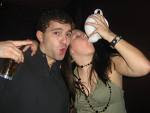eHow Contributing Writer
 Diabetes is a very common sugar and insulin disorder that often goes undetected in adults. Diabetes impacts nearly 24 million Americans. While this number is staggering by itself, it is important to note that an estimated 6 million people do not know that they have the disease. Diabetes is a disease in which the hormone known as insulin is not properly regulated, which can result in blood sugar (or glucose) imbalances.
Diabetes is a very common sugar and insulin disorder that often goes undetected in adults. Diabetes impacts nearly 24 million Americans. While this number is staggering by itself, it is important to note that an estimated 6 million people do not know that they have the disease. Diabetes is a disease in which the hormone known as insulin is not properly regulated, which can result in blood sugar (or glucose) imbalances.
There are various forms of diabetes that can range from a total lack of the body’s ability to produce insulin and regulate glucose to the body producing an ineffective amount of insulin. Proper glucose regulation is essential to normal bodily function, thought process and overall wellbeing. Poorly regulated glucose can damage virtually every internal organ and result in life-threatening infections and other conditions.
The good news about diabetes is that advances in care have been tremendous and the disease can be regulated extremely well. Given the fact that nearly 25 percent of Americans with diabetes do not know they have this serious, but treatable condition--this article will focus on the three major signs or red flags of diabetes.
SELF-ASSESSMENT OF ANY EXCESSIVE URINATION, HUNGER AND THIRST
*** Step 1 *** 
Observe if there is frequent urination. The first of the three classic symptoms (usually referred to as the P's of Diabetes) is frequent urination or polyuria. This can be a confusing symptom, since it can occur with various other medical conditions other than diabetes. For women it may be a sign of a bladder infection, and for men it may herald the onset of an enlarged prostate. The main difference, however, with diabetes-associated polyuria is that the urinary stream is typically normal without burning or hesitation, but rather frequent and ultimately annoying urination.
*** Step 2 *** Recognize excessive thirst (polydipsia). This symptom is usually noticeable since people frequently will state that they simply cannot drink enough and have never been as thirsty as this before. Essentially, the imbalance of glucose can result in another imbalance in how the body concentrates fluids (sometimes referred to as osmolarity) resulting in a craving and need to drink fluids in an attempt to correct this imbalance.
Recognize excessive thirst (polydipsia). This symptom is usually noticeable since people frequently will state that they simply cannot drink enough and have never been as thirsty as this before. Essentially, the imbalance of glucose can result in another imbalance in how the body concentrates fluids (sometimes referred to as osmolarity) resulting in a craving and need to drink fluids in an attempt to correct this imbalance.
*** Step 3 *** Notice if there is excessive hunger (polyphagia). Much like excessive thirst, excessive hunger is a rather striking symptom that patients frequently report. The sugar or glucose normally consumed by someone with new onset diabetes cannot be converted to energy and used by the body due to the insulin dysfunction, therefore a vicious cycle occurs whereby the body demands more and more food to help ward off glucose starvation, which is occurring since the insulin is absent or not effective. In essence, the body is dramatically attempting to maintain a normal blood sugar level without the full use of the regulating hormone insulin, so the brain tells the body: feed me!
Notice if there is excessive hunger (polyphagia). Much like excessive thirst, excessive hunger is a rather striking symptom that patients frequently report. The sugar or glucose normally consumed by someone with new onset diabetes cannot be converted to energy and used by the body due to the insulin dysfunction, therefore a vicious cycle occurs whereby the body demands more and more food to help ward off glucose starvation, which is occurring since the insulin is absent or not effective. In essence, the body is dramatically attempting to maintain a normal blood sugar level without the full use of the regulating hormone insulin, so the brain tells the body: feed me!
A REVIEW OF ANY FAMILY HISTORY OF DIABETES
*** Step 4 ***
Consider that family history, obesity and a sedentary lifestyle are risk factors for diabetes. Remember, treatment options for diabetes are numerous and effective and getting diagnosed and treated can dramatically improve health and quality of life. TIPS & WARNINGS
TIPS & WARNINGS
Diabetes often goes unrecognized and is on the rise in certain parts of the world. There are varying levels of altered insulin production and the treatments needed. Obesity, diets high in refined sugars and saturated fats and sedentary lifestyles are risk factors that can be altered and corrected.
***** Never assume that you are not at risk because of a healthy lifestyle *****
***** Also keep an eye on your children if you have a family history of diabetes *****
Genetics play an important role in the development of diabetes like many other diseases. Click on the following links if you want to learn about managing the diabetes symptoms of yours and your children's.
No comments:
Post a Comment